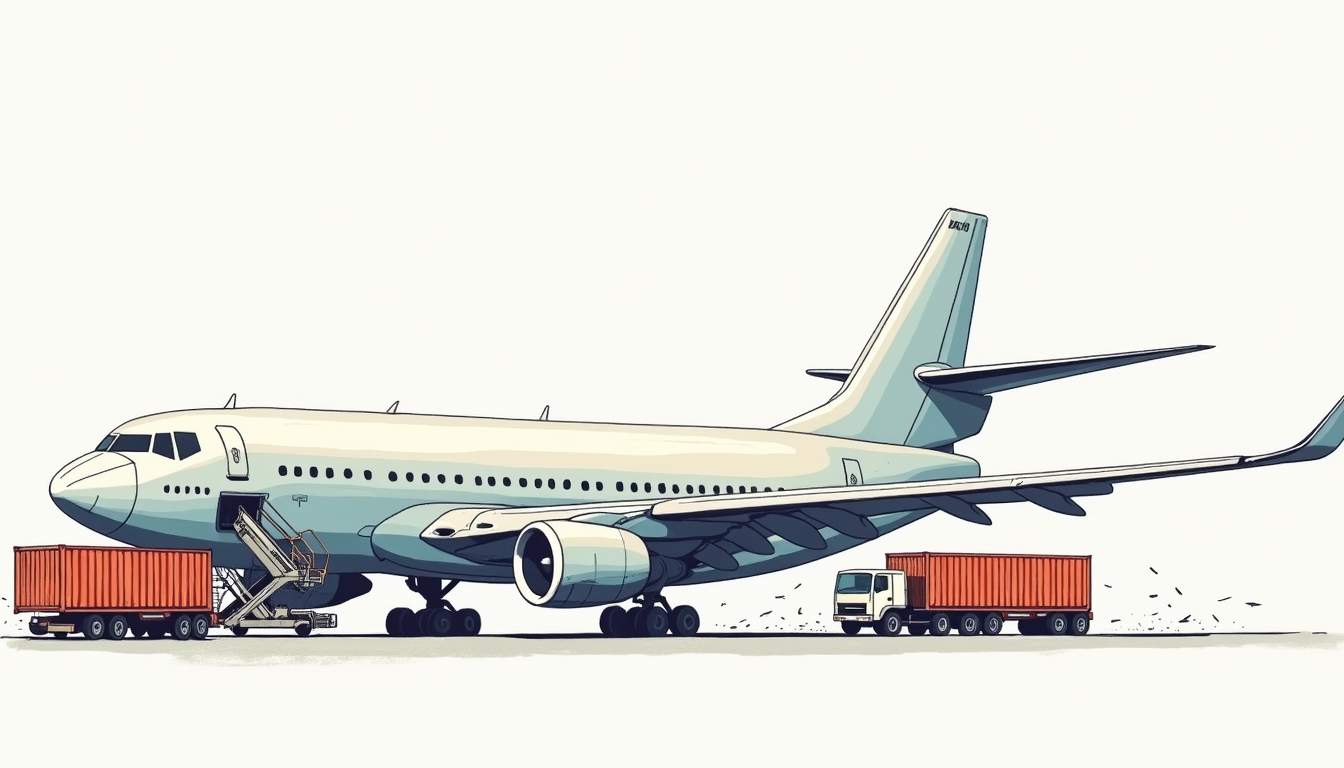In today’s fast-paced global economy, businesses are constantly seeking ways to optimize their supply chains and reduce costs. One effective strategy that has gained traction is air freight consolidation. This approach not only enhances efficiency but also offers significant savings for companies that rely on air transport for their goods. This guide delves into the intricacies of air freight consolidation, exploring its benefits, processes, and best practices.
Understanding Air Freight Consolidation
Air freight consolidation refers to the practice of combining multiple shipments from various shippers into a single shipment. This process is typically managed by freight forwarders or logistics providers who specialize in air transport. By consolidating shipments, businesses can take advantage of lower rates and improved logistics, ultimately leading to a more streamlined supply chain.
What is Air Freight Consolidation?
At its core, air freight consolidation involves grouping together smaller shipments to fill an entire cargo space on an aircraft. This not only maximizes the use of available space but also reduces the overall shipping costs for each individual shipment. Instead of paying for a full cargo load, shippers can share the costs, making air freight more accessible for smaller shipments.
Benefits of Air Freight Consolidation
The advantages of air freight consolidation are manifold. Firstly, it significantly reduces transportation costs, as shippers can benefit from bulk rates. Secondly, it enhances delivery speed, as consolidated shipments are often prioritized by airlines. Additionally, the process can improve tracking and visibility, making it easier for businesses to manage their supply chains effectively.
Moreover, air freight consolidation can lead to improved inventory management. By consolidating shipments, businesses can better align their inventory levels with actual demand, reducing the risk of overstocking or stockouts. This is particularly beneficial for companies that operate in fast-paced industries where timing is crucial. Furthermore, the environmental impact of shipping can also be mitigated, as fewer flights are needed to transport the same volume of goods, leading to lower carbon emissions per shipment.
Another significant aspect of air freight consolidation is the flexibility it offers to shippers. Businesses can adjust their shipping schedules based on demand fluctuations without incurring exorbitant costs. This adaptability is essential in today’s global market, where consumer preferences can shift rapidly. Additionally, freight forwarders often provide value-added services such as customs clearance and documentation assistance, which can further simplify the shipping process for businesses, allowing them to focus on core operations while enhancing their logistical capabilities.
The Air Freight Consolidation Process
Understanding the air freight consolidation process is crucial for businesses looking to implement this strategy. The process typically involves several key steps, each designed to ensure that shipments are handled efficiently and effectively.

Step 1: Collection of Shipments
The first step in the consolidation process is the collection of shipments from various suppliers or locations. Freight forwarders play a pivotal role in this stage, coordinating with multiple shippers to gather their goods. This may involve scheduling pickups, managing documentation, and ensuring that all shipments meet the necessary regulatory requirements. Additionally, freight forwarders must also assess the size, weight, and nature of the goods to determine the most efficient way to consolidate them. This meticulous planning helps to minimize delays and ensures that all items are ready for the next phase of the process.
Step 2: Consolidation at a Hub
Once the shipments have been collected, they are transported to a consolidation hub. This hub acts as a central point where goods are sorted and combined into larger shipments. The efficiency of this stage is critical, as it determines how quickly and effectively the consolidated shipments can be prepared for air transport. At the hub, advanced technology and logistics management systems are often employed to streamline the sorting process. This not only enhances accuracy but also allows for real-time tracking of shipments, providing shippers with updates on their cargo’s status. Furthermore, the hub may also serve as a temporary storage facility, allowing for last-minute adjustments to shipments before they are dispatched to their final destinations.
Step 3: Air Transport
After consolidation, the shipments are loaded onto an aircraft for transport. This is where the cost savings truly come into play, as the combined weight of multiple shipments allows for more economical pricing. Additionally, airlines often prioritize consolidated shipments, leading to faster delivery times. The choice of aircraft can also influence the efficiency of this step; larger planes with higher cargo capacities can facilitate the transport of more consolidated shipments at once, further reducing costs. Moreover, the use of air freight for consolidated shipments is particularly advantageous for time-sensitive goods, such as perishable items or critical components for manufacturing. By leveraging the speed of air transport, businesses can maintain their supply chain efficiency and respond swiftly to market demands.
Key Considerations for Successful Air Freight Consolidation
While air freight consolidation offers numerous benefits, several key considerations must be taken into account to ensure its success. These factors can significantly impact the efficiency and effectiveness of the consolidation process.

Choosing the Right Freight Forwarder
Selecting a reliable freight forwarder is paramount in the consolidation process. Companies should look for forwarders with experience in air freight and a solid network of carriers. A good freight forwarder will not only manage the logistics of consolidation but also provide valuable insights into optimizing shipping routes and costs.
Understanding Regulatory Requirements
Each country has its own set of regulations governing air freight. Businesses must ensure that their shipments comply with these regulations to avoid delays or penalties. This includes understanding customs documentation, import/export restrictions, and any specific requirements related to the goods being shipped.
Effective Communication
Clear communication between all parties involved in the consolidation process is essential. This includes shippers, freight forwarders, and airlines. Regular updates and transparency can help prevent misunderstandings and ensure that shipments are handled smoothly from start to finish.
Cost Savings Through Air Freight Consolidation
One of the primary motivations for businesses to pursue air freight consolidation is the potential for significant cost savings. By leveraging the benefits of consolidation, companies can optimize their shipping expenses and improve their bottom line.
Bulk Pricing Advantages
When shipments are consolidated, they often qualify for bulk pricing discounts. Airlines typically offer lower rates for larger shipments, allowing businesses to save money compared to shipping smaller loads individually. This can be particularly advantageous for companies that frequently ship goods internationally.
Reduced Handling Fees
Consolidated shipments may also incur lower handling fees. Since multiple shipments are combined, the overall handling costs are distributed among the various shippers. This can lead to substantial savings, especially for businesses that rely heavily on air freight for their logistics.
Improved Inventory Management
By utilizing air freight consolidation, businesses can enhance their inventory management. With more predictable shipping schedules and reduced costs, companies can better align their inventory levels with demand. This can lead to lower carrying costs and improved cash flow.
Challenges of Air Freight Consolidation
While air freight consolidation presents many advantages, it is not without its challenges. Businesses must be aware of these potential pitfalls to navigate the consolidation process effectively.
Space Limitations
One of the primary challenges of air freight consolidation is the limitation of available cargo space. Airlines have specific capacity constraints, and if demand exceeds supply, some shipments may be delayed or prioritized lower. Companies must plan their shipments carefully to avoid such issues.
Potential for Delays
Consolidated shipments can sometimes experience delays due to the need for additional handling and sorting. If one shipment in the consolidation is delayed, it can impact the entire load. Businesses need to account for this possibility in their logistics planning.
Complexity of Coordination
Coordinating multiple shipments from various suppliers can be complex. Effective management is required to ensure that all parties are aligned and that shipments are collected and consolidated on time. Companies may need to invest in logistics software or hire skilled personnel to manage this process efficiently.
Best Practices for Air Freight Consolidation
To maximize the benefits of air freight consolidation, businesses should adopt best practices that streamline the process and enhance efficiency. These practices can help ensure that shipments are handled effectively and that costs are minimized.
Utilizing Technology
Investing in logistics technology can significantly improve the consolidation process. Software solutions that offer real-time tracking, inventory management, and automated documentation can enhance visibility and streamline operations. This technology can also facilitate communication between all parties involved.
Regularly Reviewing Shipping Strategies
Companies should regularly review their shipping strategies to identify areas for improvement. This includes analyzing shipping costs, delivery times, and overall efficiency. By continuously refining their approach, businesses can adapt to changing market conditions and optimize their air freight consolidation efforts.
Building Strong Relationships with Suppliers
Establishing strong relationships with suppliers can lead to smoother consolidation processes. Open lines of communication and collaboration can help ensure that shipments are collected on time and that any issues are addressed promptly. This partnership can ultimately enhance the efficiency of the entire supply chain.
Conclusion
Air freight consolidation is a powerful strategy for businesses looking to maximize efficiency and reduce costs in their logistics operations. By understanding the process, recognizing the benefits, and implementing best practices, companies can navigate the complexities of air freight with confidence. While challenges may arise, the potential for significant savings and improved supply chain management makes air freight consolidation an attractive option for businesses of all sizes.

As the global marketplace continues to evolve, staying ahead of the competition requires innovative approaches to logistics. Embracing air freight consolidation can be a game-changer, enabling businesses to respond quickly to market demands while maintaining cost-effectiveness. With careful planning and execution, air freight consolidation can lead to a more efficient and profitable future.
Take Your Air Freight to New Heights with Freighter Gator
Ready to elevate your logistics operations with the efficiency of air freight consolidation? Freighter Gator is here to partner with you in achieving seamless, time-critical freight solutions tailored to your unique business needs. Our global air cargo charter services are perfect for those urgent shipments that demand reliability and speed. Don’t let logistics challenges slow you down. Request a Quote today and experience the peace of mind that comes with entrusting your cargo to the experts at Freighter Gator.
